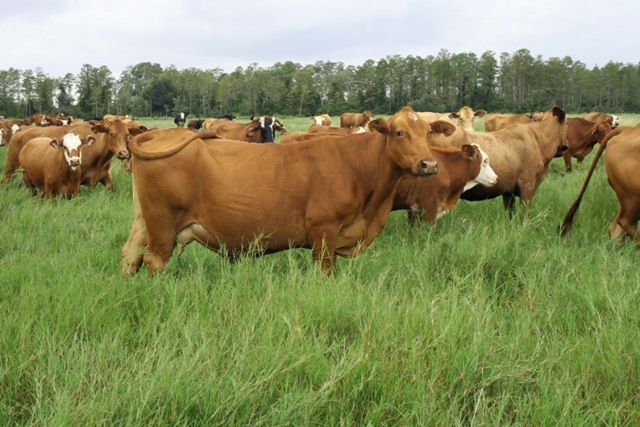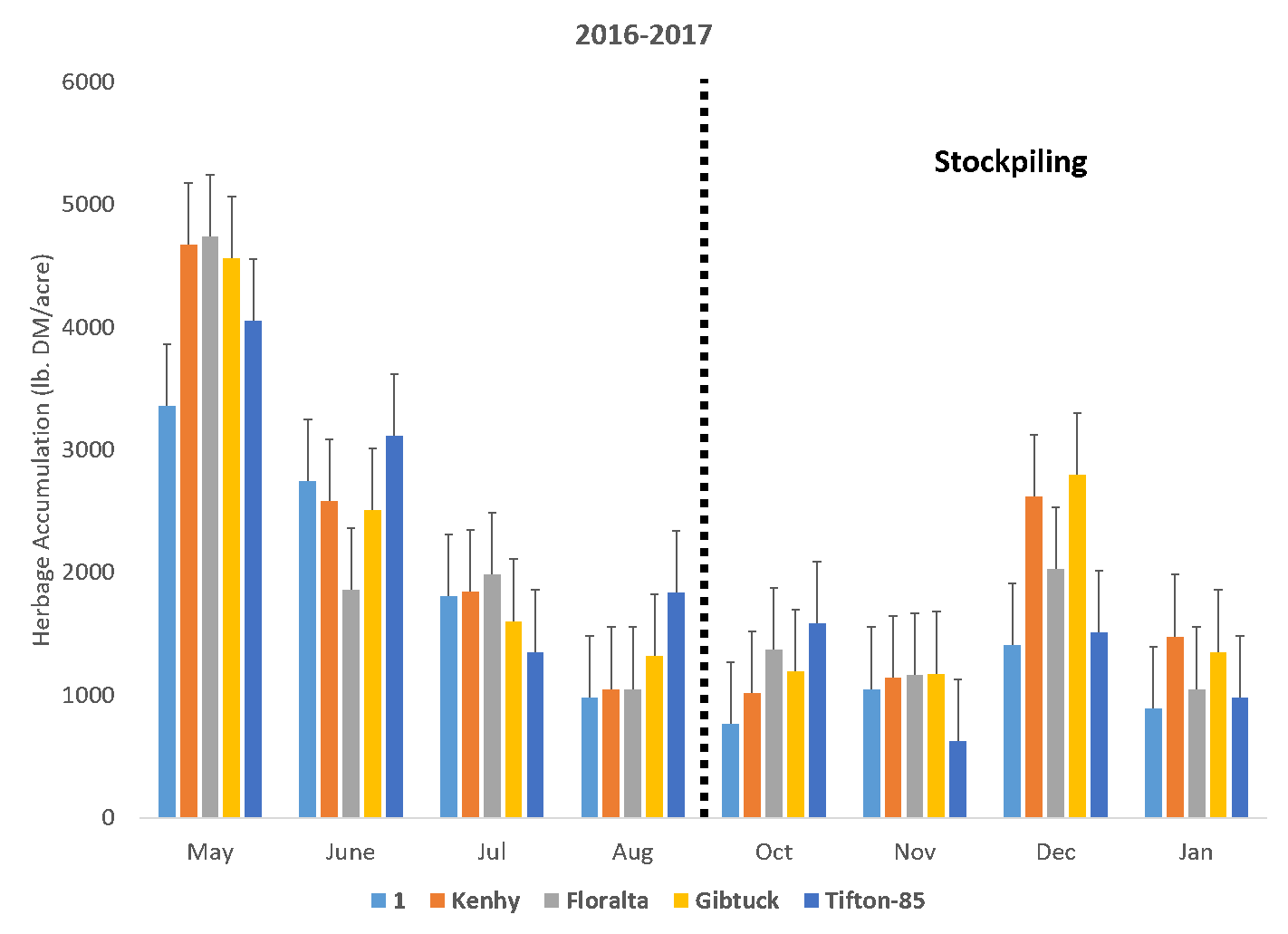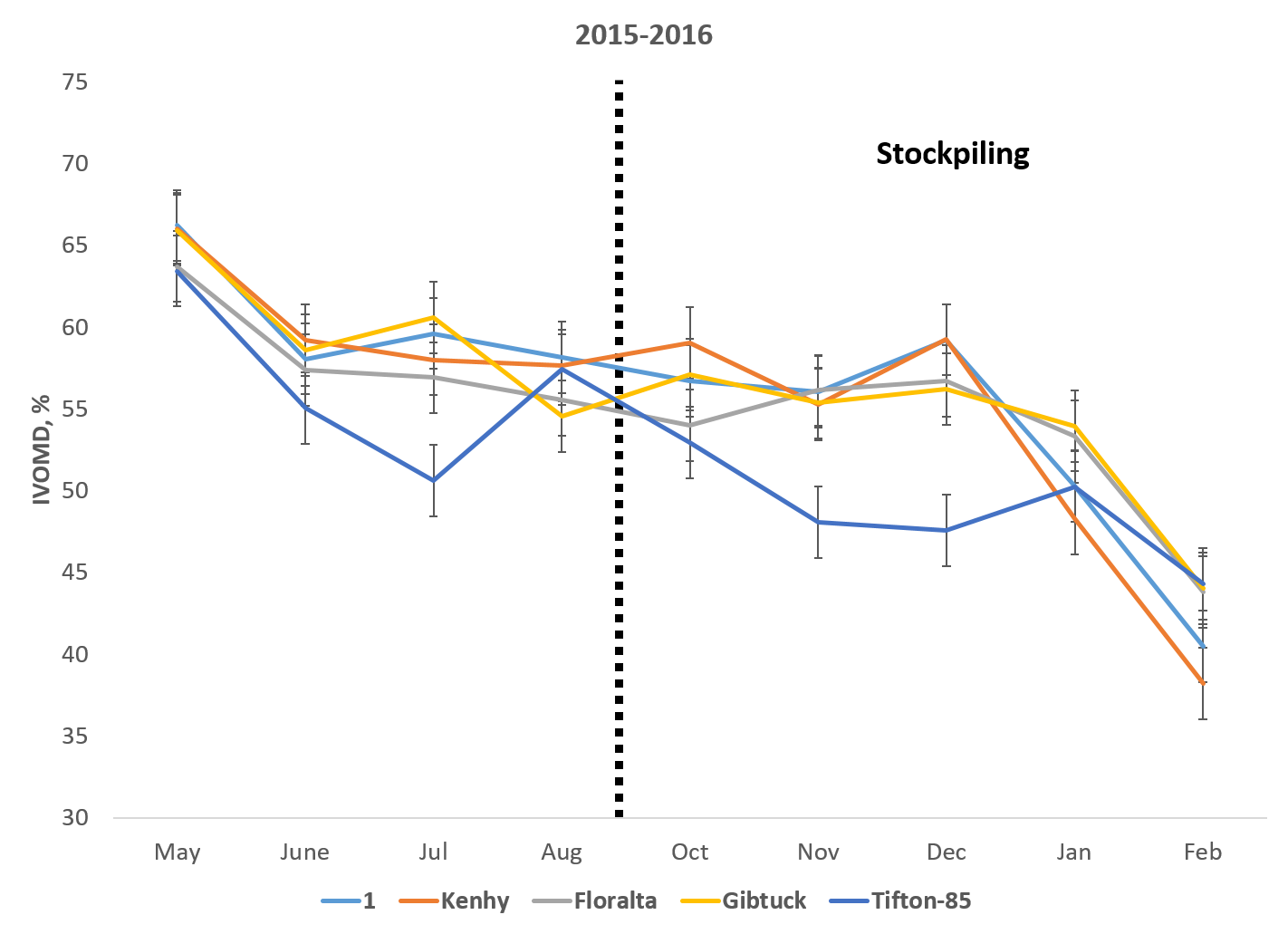
Limpograss shows real potential as an alternative forage grass for North Florida, providing significant summer growth, and can be stockpiled for grazing through December. Photo credit: Yoana Newman
Jose Dubeux, Erick Santos, David Jaramillo, Liza Garcia, UF-IFAS NFREC
Limpograss (Hemarthria altissima) has been successfully adopted in South Florida by livestock producers. This unique grass grows well in flatwood soils, and maintains its digestibility for longer periods than other warm-season grasses (e.g. bahiagrass and bermudagrass), making it a good candidate for stockpiling. Limpograss is also less sensitive to day-length than other grasses, growing during the cool-season, especially in mild-winters in South Florida. After a frost, limpograss will be one of the first warm-season grasses to initiate regrowth. The first cultivars were released in Florida during the 1970s and 80s, and include the diploids “Redalta” and “Greenalta” and the tetraploids “Bigalta” and “Floralta” (Newman et al., 2014). Recently, two new cultivars were released, “Kenhy” and “Gibtuck.” These cultivars provide increased grazing tolerance, greater productivity, and nutritive value compared to previously released cultivars (Wallau et al., 2015). Limpograss is often used for stockpiling, considering its slower loss of digestibility compared to other warm-season grasses.
The potential of limpograss in North Florida, however, has not fully been assessed. Although limpograss collections have been established in North Florida since 2005, a comprehensive evaluation including biomass productivity and nutritive value of the new cultivars has not been evaluated. The persistence of limpograss throughout these years, however, shows the possibility to grow this species in North Florida, despite the cooler temperatures compared to South Florida.
Along the Florida Panhandle there are vast areas that can potentially be used with limpograss, especially along the Gulf coast. One of the concerns of growing limpograss in North Florida is the shorter growing season, as compared to South Florida, because of the earlier frost. Comprehensive evaluations are necessary in order to assess these potential differences of limpograss performance in contrasting Florida environments.
Researchers established a limpograss trial at the UF-IFAS North Florida Research and Education Center (NFREC) in Marianna, Florida. Plots were established in July 2014 and included four limpograss cultivars (breeding line 1 and the cultivars Kenhy, Floralta, and Gibtuck). For comparison, the trial also included Tifton-85 bermudagrass as a control. From May 2015 to Feb 2017, researchers evaluated biomass productivity and digestibility (IVOMD) of these different grasses. Harvesting started in May of each year, with 5-week intervals between harvests and 7 inches cutting height. From May to August, after each harvest, plots received 60 lb. N/acre, 15 lb. P2O5/acre, and 60 lb. K2O/acre. Starting in September, a stockpiling scenario was simulated by letting the plants grow and harvesting only a portion of each plot every 5 weeks. Forage harvest measurements were taken to evaluate the cumulative growth since August.
During the summer growth of 2016, forage growth peaked in July. Gibtuck was one of the most productive among the limpograss cultivars with comparable growth to Tifton-85 Bermudagrass, which is considered one of the most productive Bermudagrass cultivars available (Figure 1). Starting in September, plants accumulated biomass until December, showing their potential for use for stockpiling in North Florida. During the primary stockpiling period, Kenhy showed the greatest potential. After December, there was limited gain in biomass accumulation for most of the cultivars (Figure 1).

Figure 1. Herbage accumulation of limpograss germplasm and Tifton-85 bermudagrass from May 2015 to Jan 2016. UF-IFAS NFREC, Marianna, FL.
In the second year (May 2016 to Jan 2017), forages peaked earlier in the growing season and declined during the summer. This likely reflects the reduced rainfall combined with the frequent harvesting (5 weeks) compromising the productivity not only of the limpograss, but also of the Tifton-85 bermudagrass. During the stockpiling period, the grasses demonstrated a similar trend of biomass accumulation until December (Figure 2).

Figure 2. Herbage accumulation of limpograss germplasm and Tifton-85 bermudagrass from May 2016 to Jan 2017. UF-IFAS NFREC, Marianna, FL.
Digestibility (IVOMD) of limpograss was often greater than Tifton-85 bermudagrass, especially during the stockpiling period (Figure 3). Limpograss digestibility (IVOMD = 55-60%) was maintained through December 2016, when it was significantly reduced, due to colder temperatures and frosts. The growth and digestibility data indicate that limpograss can be used during the summer, and for stockpiling at least through December without significant loss in digestibility. This would be sufficient to fill the November-December forage gap that often occurs in the Panhandle, allowing time for the cool-season forage production to ramp up. As a result, stockpiled limpograss could be utilized to reduce hay requirements, and ultimately reduce winter feeding expenses.

Figure 3. In vitro organic matter digestibility (IVOMD) of limpograss germplasm and Tifton-85 bermudagrass from May 2015 to Feb 2016. UF-IFAS NFREC, Marianna, FL.
Take Home Message
The results of this two-year trial in Marianna are encouraging. Limpograss shows real potential as an alternative forage grass for North Florida. Limpograss provided significant summer growth, but adds the potential use for stockpiled grazing through December. In general, limpograss was more digestible than Tifton-85 bermudagrass, especially during the stockpiling period. Variations among limpograss cultivars occurred, but those differences were not consistent over the two years. Therefore, all the cultivars tested have potential for use in North Florida. Longer-term evaluation with animal performance is still needed to fully asses the potential of limpograss in North Florida, but the results from this trial show that further evaluation is warranted.
References:
- Newman, Y.C., J. Vendramini, L.E. Sollenberger, and K. Quesenberry. 2014. Limpograss (Hemarthria altissima): overview and management. EDIS SS-AGR-320.
- Wallau, M.O., L.E. Sollenberger, J.M.B. Vendramini, M.K. Mullenix, K.H. Quesenberry, C.A.M. Gomide, V. Costa e Silva, and N. DiLorenzo. Herbage accumulation and nutritive value of limpograss breeding lines under stockpiling management. Crop Science 55:2377-2383.
- Grazing Cover Crops is a Triple Win! - August 15, 2025
- How are My Cool-season Forages Recovering from the Snowfall and Low Temperatures? - January 31, 2025
- Integrated Crop-Livestock Systems Improve Soil Health - July 26, 2024
